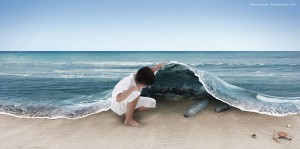
Article courtesy of Jon Fern, staff writer for Save the Water™| September 1, 2014 | Shared as educational material
Writing in The New York Times, ocean expert Charles Moore described a recent voyage during which he and his colleagues conducted research into the Great Pacific Garbage Patch. This is an area of ocean in which floating plastic and other debris has accumulated, forming a solid mass of trash the size of Texas.1
Also known as the Pacific trash vortex, the Great Pacific Garbage Patch is one of several gyres, or vortices, caused by complex interactions of the Earth’s spin and ocean currents, which have become clogged with man-made pollutants. Much of the pollution is under the surface and consists of plastic, chemical sludge, and debris trapped by currents in the upper water column.
The Pacific is not alone in having such a large accumulation of plastic waste. The Atlantic has a twin “trash vortex,” which spans an area comparable to the patch in the Pacific.2 The North Pacific Subtropical Gyre also has an accumulation of floating waste, which has been collected by the same mechanism of wind and ocean currents that has led to the formation of the Great Pacific Garbage Patch.
The Impact
Moore expressed concern that the sheer volume of plastic in the Pacific gyre was indicative of a global phenomenon that may exceed climate change in its scale of damage to the planet, pointing out that it may be harder to eradicate plastic pollution of the oceans than to reduce carbon dioxide emissions.1 The direct impact of plastic waste on marine life, Moore suggests, may be much worse than the effects of climate change, causing toxicity and death in affected organisms, including humans. Some of the toxins in fish can find their way onto our plates, since this area is commercially fished, meaning that this environmental issue is a direct hazard to human wellbeing.3
The impacts of plastic waste in the oceans is alarming: fish, seabirds, and other marine animals ingest the waste and chemicals contaminate the water itself, leading to hormone-affecting pollutants entering the food chain. It is little wonder that ocean environmentalists are concerned the situation might rival climate change in seriousness. One research team that also studied the Pacific patch suggested that plastic pollutants may also carry chemicals into the ocean, such as insecticides, and could even help to transport microorganisms, which could potentially become invasive species in their new environment.4
Moving Forward
Is there a solution to this problem? Unfortunately, removal of existing debris is extremely problematic; skimming areas of the ocean as large as the observed patches will require large amounts of both time and money, and may remove only a fraction of the pollutants. Much of the contamination exists as either sludge or as billions of pieces of microscopic degraded waste and would be almost impossible to remove.5
However, there are a number of proactive steps that can be taken, which could prevent, rather than cure, the formation of these floating islands of garbage:
• Reduce the amount of plastic that people use. For instance, place a tax on plastic bags, a major contributor to plastic pollution. This has been introduced successfully in some countries, such as Ireland, where a plastic bag levy requires shopping bags to be bought for 20 cents.
• Cover drains and urban catch basins with fine-mesh screens to cut down on debris entering seas and oceans via rivers.
• Reduce the amount of lost fishing tackle and other aqua-cultural equipment.
• Enforce laws penalizing littering and dumping.
• Recycle, recycle, recycle! Plastic containers and other products should be designed for minimal waste.
The plastic load of Earth’s oceans will only be significantly reduced by stopping pollutants from getting there in the first place, something that will require a concentrated effort and a shift in the way we think about the planet’s oceans and our connections with them.
References:
- Moore. 2014. “Choking the Oceans With Plastic.” The New York Times. http://nyti.ms/1mIk6bg
- Lovett. 2010. “Huge Garbage Patch Found in Atlantic Too.” National Geographic. http://news.nationalgeographic.com/news/2010/03/100302-new-ocean-trash-garbage-patch/
- Rios et al. 2007. “Persistent Organic Pollutants Carried by Synthetic Polymers in the Ocean Environment.” Marine Pollution Bulletin. Science Daily. http://bit.ly/2rXijLT
- Gorman. 2009. “Scientists Study Huge Plastic Patch in the Pacific. Reuters. http://reut.rs/2qY4CJp
- Bawden. 2014. “Plastic Rubbish Heaps at Sea Pose Bigger Threat to Earth Than Climate Change, Claims Ocean Expert.” The Independent.

